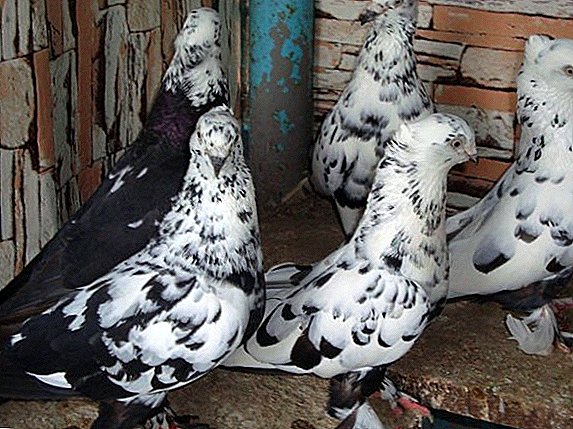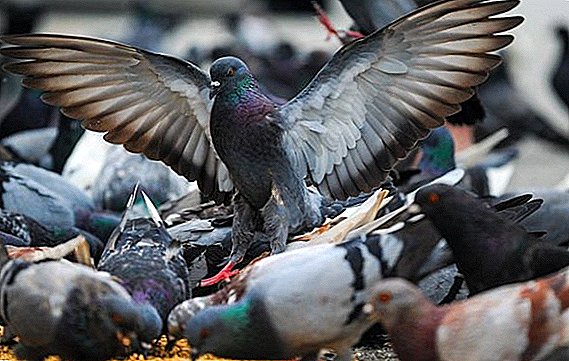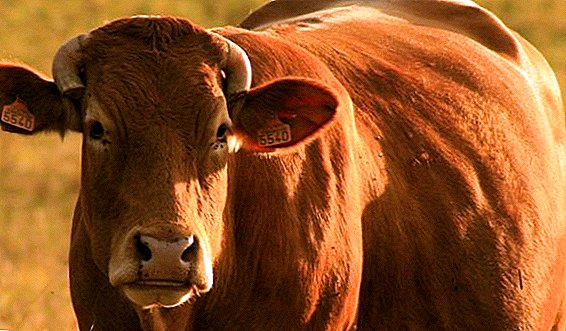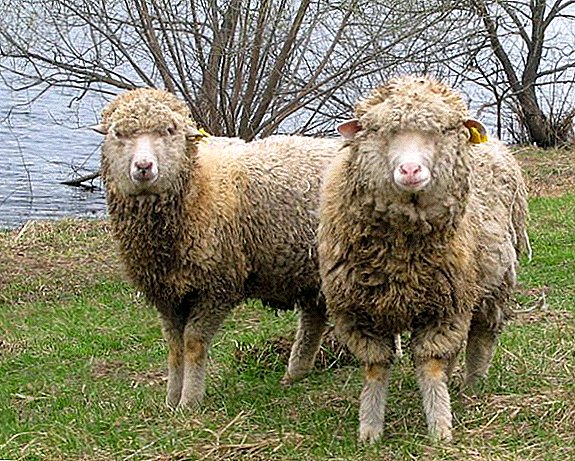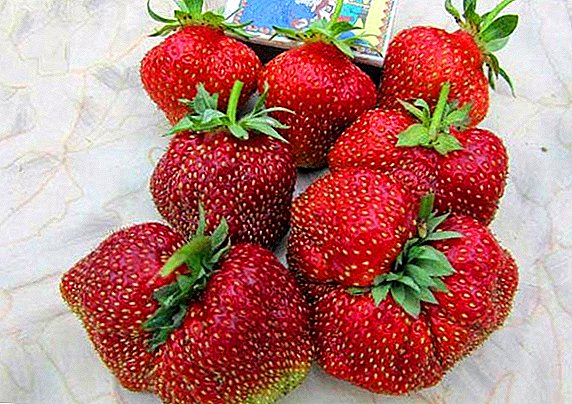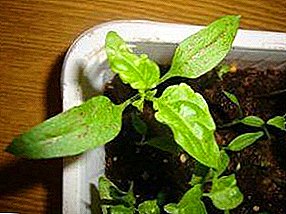 Most of the lovers of "quiet hunting" is known such a inhabitant of the forest as a row purple. This fungus is ubiquitous in temperate climates, but not many people decide to put it in a basket. The bright and memorable color of the rows often frightens the mushroom picker and therefore few people enjoy this gift of nature. And in vain, it can please not only with an unusual shade, but also with unique taste qualities that can highlight any dish. Learn everything about grading purple, how to distinguish it from other mushrooms, and how to cook it properly.
Most of the lovers of "quiet hunting" is known such a inhabitant of the forest as a row purple. This fungus is ubiquitous in temperate climates, but not many people decide to put it in a basket. The bright and memorable color of the rows often frightens the mushroom picker and therefore few people enjoy this gift of nature. And in vain, it can please not only with an unusual shade, but also with unique taste qualities that can highlight any dish. Learn everything about grading purple, how to distinguish it from other mushrooms, and how to cook it properly.
Rowing purple: photo and description
Rowing purple (lepista naked) refers to the species representing the genus Lepista, family Ryadkovye. Mushroom refers to conditionally edible, and this means that it is strictly forbidden to use it raw.
The most popular edible mushrooms are: chanterelles, white mushrooms, russules, honey agarics, volushki, ryadovki, mokhovik, milk mushrooms, boletus mushrooms and boletus.
Therefore, in order to enjoy the rowing, it is necessary to carefully boil it, and only then succumb to basic culinary processing.
Video: how purple looks But this does not mean that the lepist is naked is a dangerous and poisonous fungus, it does not contain highly toxic substances, but the use of such a product in its raw form can cause serious indigestion.
Did you know? The first mention of such a life form as mushrooms is found in IV BC. er in the writings of the ancient Greek philosopher Aristotle.
In addition, the row has a fairly bright appearance, similar to some poisonous representatives of the mushroom kingdom, so that its use does not end with serious consequences, you must carefully deal with the morphological features of the species.
Hat
The hat in all representatives of the species can reach a diameter of 6-15 cm. Initially, its color is a distinct purple hue, but over time it changes to a pale lilac with a slight manifestation of brown tones.  Often the cap is flat or slightly convex, its edges are not uniform.
Often the cap is flat or slightly convex, its edges are not uniform.
In structure, it is dense, fleshy, but sometimes it can be watery. The lower part of the cap, which carries spore-bearing organs, is also of a bright violet hue, which eventually fades to a grayish-purple color.
We recommend that you learn more about the beneficial properties of the mushrooms of the rows, as well as their varieties, such as green rowder (greenfinch), poplar rowed and gray rowted (grasses).
Pulp
The flesh of the young ryadovki fleshy, dense, almost always elastic, grayish-purple. Over time, it becomes softer, and its shade changes to ocher-cream tones. The smell of the fungus is characteristic, it is mostly persistent, but pleasant aroma of anise.
Records
The plates are always numerous, thin and wide, adherent to the tooth, but in some cases crescent-shaped, almost always free.
Initially they have a bright purple hue, which eventually fades to a delicate light purple color.
Leg
The leg of all representatives of the species is flat, smooth and fibrous, of a cylindrical shape and thickens towards the base. In young mushrooms, it is solid, but over time, cavities form in the pedicle.  Under the bonnet there is a flaky bloom on it. Its color ranges from light purple to slightly pale shades of mauve. The height of the leg can reach from 4 to 8 cm, thickness - not more than 1.5-2.5 cm.
Under the bonnet there is a flaky bloom on it. Its color ranges from light purple to slightly pale shades of mauve. The height of the leg can reach from 4 to 8 cm, thickness - not more than 1.5-2.5 cm.
At the base of the stem violet pubescence develops - the so-called mycelium.
Spores and Spore Powder
Spore powder at the row always has a light pink or pinkish-yellow hue.
Spores are small and numerous, slightly rough, ellipsoidal, pink shade. Their length is in the range of 6-8 microns, width no more than 4-5 microns.
Did you know? In nature, there are predatory fungi, these are representatives of the genera arthrobothris, dactylarium, monacroporium, tridentaria, triposporm. With the help of mycelium, they create small traps for catching and peretravlivaniya small soil worms.
Where do mushrooms grow: ecology and distribution
Lepista naked everywhere in the northern hemisphere, in temperate climates. This is an unpretentious saprophytic species that can be found in forests with diverse vegetation, but in most cases the species is a faithful companion of fir-hornbeam, pine or spruce plantations.
Substrate for growth can be any leaf or coniferous litter, but it grows best on coniferous or hardwood humus.  There is a lepist on open forest areas, usually in groups of several individuals or in small densely populated meadows.
There is a lepist on open forest areas, usually in groups of several individuals or in small densely populated meadows.
You can also see the view along forest roads, in grooves, in the needles of spruce or pine forests, and even in the backyards near the forest, near compost, brushwood, or straw heaps.
The traditional companion of purple is a smoky govorushka, which is found next to in small groups or numerous cenoses.
Rivings are collected throughout the fall, from early September until the first serious frosts.
Mushrooms are a unique natural product with a large number of vitamins and amino acids, but a number of mushrooms contain poisons, salts of heavy metals and are dangerous for human life. That is why read the list of edible and poisonous mushrooms, as well as learn how to check the mushrooms for edibility by folk methods.
Is it possible to confuse rowing purple: similar species
Despite its bright and uncharacteristic color for our climatic zone, the lepist is still not unique, so it’s pretty easy to come across a similar look to it.
In most cases, related species disappear into the basket, which, after careful processing, is quite suitable for the preparation of various dishes.
However, often inexperienced mushroom pickers get into the hands of truly dangerous species, the use of which can result in severe poisoning.  Next, we will examine in detail who can hide behind a mask of lepists and whether to eat such mushrooms.
Next, we will examine in detail who can hide behind a mask of lepists and whether to eat such mushrooms.
Did you know? The largest mushroom in the world was found on Hanan Island in 2011 by the scientist of the Chinese Academy of Sciences Yu Cheng Daem. Its weight was about 500 kg.
Edible
Most often, the lepist can be confused with non-toxic related species belonging to the family Ryadkovye. These include:
- violet-legged lepista: lamellar, conditionally edible form. Most often it can be seen in areas with a subtropical climate. Cyclave grows in fields or meadows, but small colonies can also be found in the forest zone. A distinctive feature of the fungus is a light, almost snow-white hat and a purple foot. There is a view from the middle of spring and up to the first frosts;
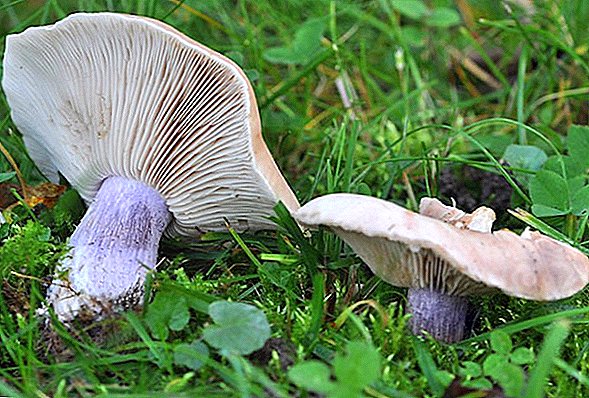
- lepista violet: conditionally edible agaric, found in the zone of dense forest plantations of temperate climate. You can distinguish it with a characteristic color, which is within the range of whitish and pinkish-brown shades. In the center of the cap, the shade is often darker than on the periphery. The cap is convex, with jagged edges. A distinctive feature of the form is a bright violet smell of pulp, which does not disappear even after a thorough heat treatment. Mushroom grows from early September until the second half of November;
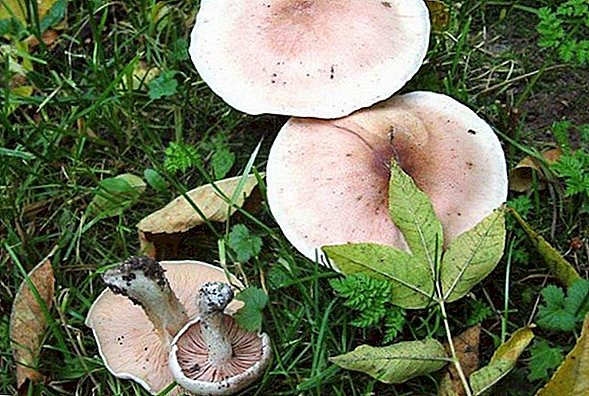
- Violet pot: conditionally edible lamellar species found on the moist soils of the temperate climate zone in the period from the second half of June to the middle of autumn. Unlike ryadovki, lakovitsa has more miniature size, so its hat in diameter is not more than 5 cm. In young forms, it is convex, but with age it becomes more flat. The plates are thin and rare, descending. The leg is thin and smooth. At a young age, the paintwork has a bright uniform purple hue, but with age it fades and becomes more pale. The flesh is also brightly colored, purple, uniform in color;

- Also, a mushroom picker in the forest may also come across spider web purple, a rare Red Book, conditionally edible plate-type species of the Spiderweb family. You can meet him in deciduous and coniferous forests in a zone with a temperate climate. The cap of the spider web is convex, with curled edges or lowered and straight in maturity. A distinctive feature of the fungus can be called a slightly brownish or dark purple hue, which evenly spreads throughout the body. In addition, the plates in the species are rare, dark purple, and the spore powder is rusty brown in color. The flesh is also saturated purple, but with age it can fade to more pale bluish tones, its flavor is delicate, with a distinct nutty flavor. There is a spider web from the beginning of August to the second half of September.
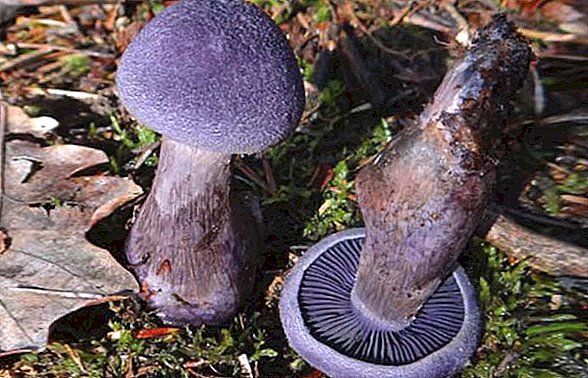
Did you know? The most expensive mushroom in the world is white truffle, and the price for such a product can reach $ 100,000 per 1 kg.
Inedible
Especially beware of the following twin twins purple:
- spider web white-purple: inedible lamellar species of the cobweb family. To reduce its negative effects on the body requires prolonged heat treatment. The fungus can be recognized by a rounded-bell-shaped or convex cap with an uneven surface with a diameter of 4-8 cm, located on a thin stem, up to 8 cm long. The spiderweed is mostly lilac-silver, pale-lilac. With age, the color fades strongly to off-white, sometimes with a slight yellowness. The pulp of the fungus is thick, soft, watery in the leg, turning brown at the break. It is also possible to recognize the spider web of violet by the characteristic unpleasant, moldy smell. The species is widespread in forest areas with a temperate climate, the season of mass appearance lasts from the end of August to the end of September;
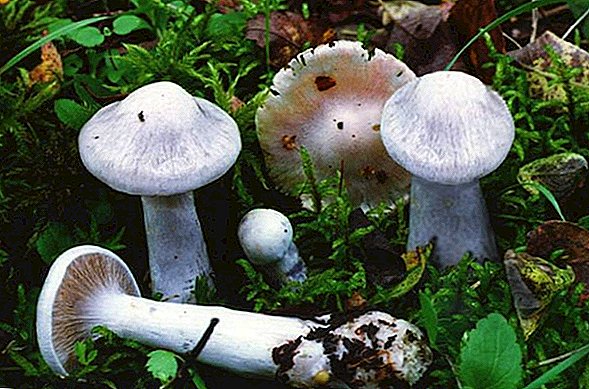
- goat spider web: Absolutely inedible lamellar species of the Spider-family. It is possible to recognize the mushroom by a hemispherical cap with curled edges with a diameter of 6-12 cm, a thick and short stem with a tuberous thickening about 6-10 cm long and a bright violet-gray shade. The flesh of goat's spiderwebs is thick, grayish-purple, with a strong unpleasant odor resembling acetylene. The fungus does not contain hazardous toxic substances, however, a strong and unpleasant odor is practically not eliminated even with prolonged treatment. The species is widespread in coniferous and mixed forest zones with a temperate climate, and the period of mass occurrence from mid-July to early October;
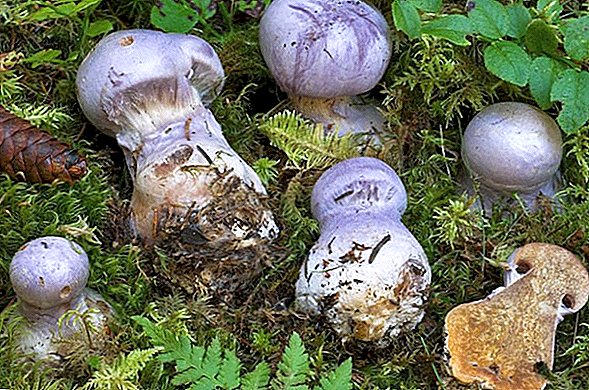
- mizena clean: inedible lamellar species of the Myzen family. The mushroom has a rather miniature size relative to the row. First of all, it is a hemispherical or shirokokonicheskaya cap with a diameter of 4 cm and a long thin leg up to 9 cm in height. The leg at the base can be covered with long hairs. The color of the fungus is pale grayish, sometimes pale brown, the edges of the caps are translucent, and have characteristic stripes. The flesh is thin and watery, pale gray or gray in color, on the fault often produces a huge amount of fluid. Like the previous form, Mitzen is characterized by a strong and unpleasant smell, which is not eliminated even with prolonged treatment. There is a species in forest zones of temperate climate on the remnants of fallen wood from early spring to the second half of June.
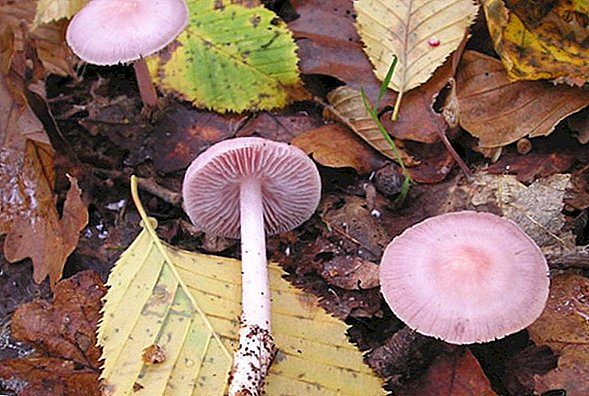
Important! If you are not an experienced mushroom picker, do not be lazy to incise every collected specimen. A sign of a real rowing will be the appearance on the cut of a distinct purple hue.
How to select and prepare mushrooms for cooking
Despite the current opinion about the complexity of cooking conditionally edible mushrooms, in fact, this process does not include specific culinary stages, so even a schoolboy can cope with this task.
The main thing is to strictly observe the sequence of all technological operations and strictly adhere to their basic principles. Only in this case, the row will become not only extremely tasty, but also a safe delicacy.
Sorting and cleaning mushrooms
After you have collected the required number of mushrooms and got to your own kitchen, the first thing to do is carefully sort the mushrooms, as the rows should be processed exclusively in the circle of representatives of their own species.  In addition, to protect yourself from poisoning, you should once again carefully examine the crop. Collected mushrooms must strictly comply with the morphological features described above.
In addition, to protect yourself from poisoning, you should once again carefully examine the crop. Collected mushrooms must strictly comply with the morphological features described above.
Rowing should have a characteristic color, there can be no remnants of a mushroom ring (like a spider's web), any ornament on a hat (like a mycene), etc.
Important! If you are not sure that one or another mushroom belongs to edible varieties, such a unit must be rejected. This will help protect themselves from severe poisoning.
After scrupulous sorting, the crop must be thoroughly cleaned from debris and sand. To do this, the mushrooms are poured on a clean newspaper or plastic wrap, and then with the help of a knife they are cleaned from the remnants of soil, forest litter and other impurities.
After that, the mycelium should be cut off and the row should be checked for any darkening or wormholes, the affected areas are cut off.
How to prepare mushrooms
Sometimes collected in the forest rowings can taste bitter - this is a consequence of the growth of the fungus on substrates rich in resinous substances.
Video: how to process mushrooms ryadovki (for example, ryadovki poplar) To protect yourself from this trouble and to clean the fungus from pollutants to the maximum, after cleaning the fruit should be soaked in salted water for a period of 12 to 72 hours.
Best of all, if during this period the water will periodically change to fresh - this will help to intensify the process of releasing the fungus from bitterness.
As mentioned above, violet lepist belongs to conditionally edible species, so after sorting and cleaning the crop must necessarily be subjected to preliminary heat treatment.
To do this, mushrooms are boiled in saline for 20-25 minutes.
It is prepared from 1 tbsp. tablespoons of salt and 1 liter of water, the liquid consumption is 1 l per 1 kg of mushrooms. After boiling, 6 peas of black pepper, 1 bay leaf and 2 buds of dried cloves are added to the pot with the solution and the rows.  At the end of cooking, the fruit is separated from the liquid and washed thoroughly. To carry out the procedure for more than 25 minutes is not recommended, as this will lead to the loss of the product of its product.
At the end of cooking, the fruit is separated from the liquid and washed thoroughly. To carry out the procedure for more than 25 minutes is not recommended, as this will lead to the loss of the product of its product.
Important! The decoction of ryadovok strictly forbidden to use for food, as it can cause serious disorders of the gastrointestinal tract. After preliminary heat treatment, it must be disposed of.
Cooking recipes
After preliminary preparation, the preparation of various dishes from lepists is practically no different from the culinary processing of other species.
Mushroom is boiled, fried, pickled and salted. After that, it becomes a real highlight of any dish, as the rows have a soft mushroom aroma and memorable flavors.
Consider the most simple recipes for making this gift of nature.
How to fry
To cook fried ryadovki:
- Peel the fruit from forest litter and sand, soak them for 12-72 hours in salted water.
- Boil rowing in salted water for 20-25 minutes.
- Cool and lightly dry with a paper towel boiled mushrooms.
- Pour a small amount of sunflower oil onto the hot pan (the layer should cover the entire heated area), and then put the mushrooms in one layer.
- Fry the rows on medium heat for 10 minutes. To mushrooms not burned, they must be periodically mixed.
- After 10 minutes of roasting, salt and spices are added to the fruits to taste, and then 2-3 minutes more slowly tantal until cooked. To improve the taste of mushrooms, they can additionally be diluted with a small amount of a mixture of onions, garlic, greens and 2 tbsp. spoons sour cream.
 Fried purple randovki in sour cream. You can eat fried mushrooms as a main dish or as an additional ingredient. As a garnish, boiled macaroni or fried potatoes are suitable for fried rows.
Fried purple randovki in sour cream. You can eat fried mushrooms as a main dish or as an additional ingredient. As a garnish, boiled macaroni or fried potatoes are suitable for fried rows.How to pickle mushrooms
Rowing is done in two ways - these are the so-called hot and cold methods. Often they have a common goal - to keep mushrooms until the next season, but such products in each case have their own characteristics.
Mushrooms can be prepared for the winter in different ways, for example, pickle, pickle, dry or just freeze.
When hot salting mushrooms can be used as food in a week, these mushrooms are soft and tender.
Cold pickling lasts a longer period, such a product has a special aroma and crispy structure. Let us consider in more detail the main stages of the processes.  In order to pickle ryadovki cold:
In order to pickle ryadovki cold:
- Peel the fruit from forest litter and sand.
- Thoroughly wash the pickling tank and sterilize it with boiling water. Traditionally, wooden containers are used for this culinary process; however, any vessel available in the household is suitable for this process.
- Put the mushrooms in a container for salting in several layers (caps should look down). Each layer should be filled with a small amount of a mixture of salt and spices (any to taste).
- The top of a tightly filled vessel must be covered with a clean cloth, cover, cover and lay a pressure on top.
- Salting should be carried out in a dry and cool place at a temperature of 0 to + 5 ° C for 30 days.
To make a hot pickle product:
- Peel the fruit from forest litter and sand, soak them for 12-72 hours in salted water.
- Boil rowing in salted water for 20-25 minutes.
- Prepare a container for salting (from wood, metal or glass). For this it is necessary to thoroughly wash and sterilize with boiling water.
- Put the hot mushrooms in a container for salting in several layers (caps should look down). Each layer should be filled with a small amount of salt and a mixture of garlic, onion and greens.
- The top of a tightly filled vessel must be covered with a lid and put a pressure on top.
- Salting should be carried out in a dry and cool place at a temperature of 0 to + 5 ° C for 7 days.
Video: how to pickle purple hot
Important! In order to avoid darkening during cooking, add 1 pinch of citric acid to the solution. Such a small trick boosts the look of the mushroom at times.
Rowing purple is one of the most common edible mushrooms in areas with a temperate climate in the Northern Hemisphere. This species has been used for cooking for centuries, but not many people know about it.
Despite the existence of many stereotypes regarding ryadovki, dishes from it have a special flavor, so everyone should eat it at least once. However, so that the use of the fungus does not result in severe disorders of the gastrointestinal tract, the mushrooms require mandatory and thorough preliminary preparation.









